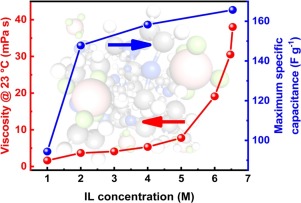Applied Materials Today ( IF 7.2 ) Pub Date : 2019-12-09 , DOI: 10.1016/j.apmt.2019.100522 Shao Ing Wong , Han Lin , Jaka Sunarso , Basil T. Wong , Baohua Jia

|
Electrolyte properties play an important role to determine the capacitive performance of electric double-layer capacitors (EDLCs), especially the specific capacitance and energy density. In general, electrolytes with a high electrochemical stability window (ESW) can offer both higher specific capacitance and energy density, which explains why ionic liquid (IL)-based electrolytes have been extensively studied. The concentration of IL is a critical parameter to control its viscosity, ionic conductivity, and potential window that is reflected in EDLC working voltage, which has yet to be systematically studied. In this paper, we presented a systematic approach to determine the optimum IL concentration for graphene-based EDLCs by measuring the viscosity and ionic conductivity of IL electrolyte containing different amounts of organic solvent and the corresponding maximum working voltages (MWV) of EDLCs via cyclic voltammetry (CV), as well as the associated specific capacitances. Such a systematic study fills in the missing knowledge on the optimum ionic liquid-based electrolyte concentration for graphene-based supercapacitors applications. We found that the electrolyte viscosity increases exponentially with increasing IL concentration, while the ionic conductivity decreases with an increase in IL concentration beyond its maximum at 2 M EMIMBF4/IL. The specific capacitance shows a strong dependence not only on the electrolyte viscosity and ionic conductivity, but also the MWV where electrode specific capacitance increases with the MWV of EDLCs. Therefore, despite the highest viscosity and the lowest ionic conductivity, the neat IL (i.e., EMIMBF4 in this work) offers the largest specific capacitance and energy density among all IL concentrations for graphene-based EDLCs due to the largest MWV offered by the neat ILs. However, if the EDLC is not required to operate at the ESW of the IL, diluted IL electrolytes with an optimized concentration/IL viscosity can be used instead to achieve the most economic EDLC performance. In conclusion, the concentration of IL electrolyte should be optimized according to the working voltage required.
中文翻译:

高能密度石墨烯超级电容器基于离子液体的电解质浓度的优化
电解质特性在确定双电层电容器(EDLC)的电容性能(尤其是比电容和能量密度)方面起着重要作用。通常,具有高电化学稳定性窗口(ESW)的电解质可以提供更高的比电容和能量密度,这可以解释为什么对基于离子液体(IL)的电解质进行了广泛的研究。IL的浓度是控制其粘度,离子电导率和EDLC工作电压中反映的电势窗口的关键参数,目前尚待系统研究。在本文中,通过循环伏安法(CV)以及相关的比电容。这种系统的研究填补了有关石墨烯基超级电容器应用中最佳离子液体基电解质浓度的知识不足。我们发现电解质粘度随IL浓度的增加呈指数增加,而离子电导率随IL浓度的增加(超过2 M EMIMBF 4 / IL的最大值)而降低。比电容不仅对电解质粘度和离子电导率表现出强烈的依赖性,而且对MWV也有很大的依赖性,其中电极比电容随EDLC的MWV的增加而增加。因此,尽管具有最高的粘度和最低的离子电导率,但纯净的IL(即EMIMBF 4由于纯净IL的MWV最大,因此在基于石墨烯的EDLC的所有IL浓度中提供了最大的比电容和能量密度。但是,如果不需要EDLC在IL的ESW下运行,则可以改用具有最佳浓度/ IL粘度的稀释IL电解质来获得最经济的EDLC性能。总之,应根据所需的工作电压优化IL电解质的浓度。











































 京公网安备 11010802027423号
京公网安备 11010802027423号